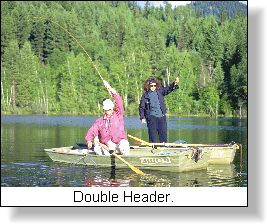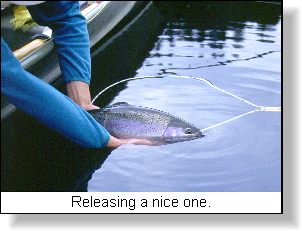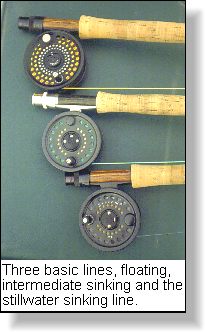
Choosing
the Right Fly Line
with
Brian Chan
Flyfishing
in lakes would be a lot easier if trout only fed on food items floating
high on the surface film as this would require only a floating fly line
to present our imitations.
 Unfortunately,
the majority of trout feeding occurs subsurface and at times in water
greater than 8 metres deep. This means having a selection of sinking fly
lines as well as the floating line to effectively have a closer look at
the basic fly lines that should be in every stillwater anglers tackle
bag. Unfortunately,
the majority of trout feeding occurs subsurface and at times in water
greater than 8 metres deep. This means having a selection of sinking fly
lines as well as the floating line to effectively have a closer look at
the basic fly lines that should be in every stillwater anglers tackle
bag.
Floating
Lines
Floating
lines are actually quite versatile in that you can use them for presenting
dry flies as well as fishing nymphs or insect larvae from just sub surface
to deep in the water column. The limiting factors on how deep you can
fish with the floating line is leader length and the angler's patience
to wait for the fly pattern to sink to the desired fishing depth. In reality,
floating lines are effective when fishing water to about 5 to 6 metres
deep with leaders as long as 7 metres in length. Most anglers will find
leaders longer than that extremely difficult to cast. Look at the floating
lines as a 30 metre long bobber and by varying the length of leader used
you can effectively cover the shallow shoal or littoral area of a lake
which is where the majority of trout feeding occurs. Floating lines are
a good choice when fishing chironomid
larvae and pupae, mayfly
nymphs, damselfly
nymphs, caddis
pupae and of course the adult forms of these insects. Using weighted fly
patterns further expands the effectiveness of the floating line. I always
carry 2 reels set up with floating lines. One line has a longer leader
of 5 to 6 metres in length and the other with a shorter 3 to 4 metre long
leader. Regardless of leader length used to make sure it is tapered so
that the fly will turn over on completion of the cast.

 Intermediate/Type
1 slow sinking Intermediate/Type
1 slow sinking
This fly
line sinks at a rate of between 1 and 2 inches/second. This slowest sink
rate gives you the ability to retrieve a fly in a very precise or narrow
depth range which can be critical when fishing chironomid pupa, emerging
mayfly nymphs, migrating damselfly nymphs and emerging caddis pupae. As
with any sinking fly line the longer you wait the deeper the line will
sink, but again, this line has the slowest sink rate and thus is an excellent
line for water less than 6 metres deep. Use of these lines reduces the
amount of time you have to wait for flies to sink which for beginning
flyfishers is important as the skill of learning to be patient has not
been fully developed. Leaders from 3 to 4 metres long work well with this
slow sinking line.
Another excellent
sinking line is the "Stillwater" line manufactured by Scientific
Anglers. This is a clear monofilament line that has a sink rate slightly
faster than slow sinking lines. The Stillwater line is virtually invisible
to fish and is a good choice when fishing very clear waters. An added
bonus of this line is its ease of casting. Once wet, the monofilament
line stays lubricated and has noticeably less friction when passing through
the rod guides. I prefer to use this line when fishing the deeper parts
of the shoal of the lake.


Fast Sinking/Type
III Sinking
 These
lines sink at rates between 3 and 5 inches/second depending on the line
weight. They are ideal lines to fish parallel to, and over the edge of
drop-offs. Drop-offs are best described as that zone of the lake where
the shallow shoal water rapidly deepens and you can no longer see the
bottom of the lake. Drop-offs are ideal habitat for trout for several
reasons. First, the deeper water at the base of the drop-off is cooler
than at the surface, which is critical during warmer summer months. Secondly,
most drop-off areas are still under the influence of photosynthesis so
plant growth is still abundant which means good insect/invertebrate habitat
and thus fish food. Thirdly, the deeper the water along the drop-off provides
better protection to fish from the predators. These
lines sink at rates between 3 and 5 inches/second depending on the line
weight. They are ideal lines to fish parallel to, and over the edge of
drop-offs. Drop-offs are best described as that zone of the lake where
the shallow shoal water rapidly deepens and you can no longer see the
bottom of the lake. Drop-offs are ideal habitat for trout for several
reasons. First, the deeper water at the base of the drop-off is cooler
than at the surface, which is critical during warmer summer months. Secondly,
most drop-off areas are still under the influence of photosynthesis so
plant growth is still abundant which means good insect/invertebrate habitat
and thus fish food. Thirdly, the deeper the water along the drop-off provides
better protection to fish from the predators.
Typical drop-off
water is 6 to 8 metres deep thus making the use of faster sinking lines
practical. Common trout food sources that inhabit the vegetation covering
the drop-off include shrimp
, dragonfly
nymphs and leeches
. To ensure your fly is being retrieved as close to the lake bottom as
possible do a simple calculation of how long it will take the fly line
to sink to the lake bottom in the depth you are anchored in. Every sinking
fly line will have the sinking rate identified on the packaging. For instance,
if you were anchored in 6 metres (20 feet) of water and using the extra-
fast sinking line that sank at a rate of 4 inches/second, if would take
60 seconds for that line to reach the bottom. If you continually snag
bottom vegetation reduce the amount of time you wait before beginning
the retrieve.
These 4 basic
fly lines will allow you to effectively cover all the insect hatches and
other invertebrates that are important trout food in lakes. A good understanding
of the life cycles and habitat preference of these food sources will allow
you to choose the right fly line for the hatch you are encountering that
day.
Brian Chan
riseform@shaw.ca
Brian's
Articles...
|




 Unfortunately,
the majority of trout feeding occurs subsurface and at times in water
greater than 8 metres deep. This means having a selection of sinking fly
lines as well as the floating line to effectively have a closer look at
the basic fly lines that should be in every stillwater anglers tackle
bag.
Unfortunately,
the majority of trout feeding occurs subsurface and at times in water
greater than 8 metres deep. This means having a selection of sinking fly
lines as well as the floating line to effectively have a closer look at
the basic fly lines that should be in every stillwater anglers tackle
bag. Intermediate/Type
1 slow sinking
Intermediate/Type
1 slow sinking
 These
lines sink at rates between 3 and 5 inches/second depending on the line
weight. They are ideal lines to fish parallel to, and over the edge of
drop-offs. Drop-offs are best described as that zone of the lake where
the shallow shoal water rapidly deepens and you can no longer see the
bottom of the lake. Drop-offs are ideal habitat for trout for several
reasons. First, the deeper water at the base of the drop-off is cooler
than at the surface, which is critical during warmer summer months. Secondly,
most drop-off areas are still under the influence of photosynthesis so
plant growth is still abundant which means good insect/invertebrate habitat
and thus fish food. Thirdly, the deeper the water along the drop-off provides
better protection to fish from the predators.
These
lines sink at rates between 3 and 5 inches/second depending on the line
weight. They are ideal lines to fish parallel to, and over the edge of
drop-offs. Drop-offs are best described as that zone of the lake where
the shallow shoal water rapidly deepens and you can no longer see the
bottom of the lake. Drop-offs are ideal habitat for trout for several
reasons. First, the deeper water at the base of the drop-off is cooler
than at the surface, which is critical during warmer summer months. Secondly,
most drop-off areas are still under the influence of photosynthesis so
plant growth is still abundant which means good insect/invertebrate habitat
and thus fish food. Thirdly, the deeper the water along the drop-off provides
better protection to fish from the predators.